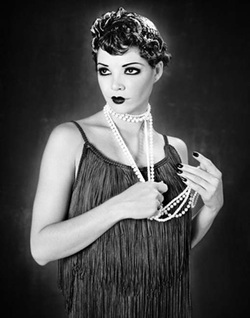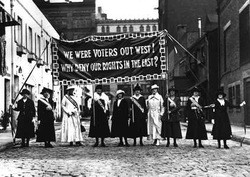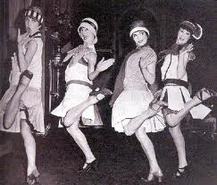Women
Essential Question: How does the Flapper represent the "new woman"? Were the 1920's successful for the women's movement?
The 1920's Flappers represents the "new woman" because they were the first generation of women who all thought for themselves and had their own opinions. Also, they represent the "modern woman" too, because they started to against the normal structure of society. The flapper also wore and did what she want, because she was able to. The 1920's was very successful for the women's movement, because it gave them a voice in society, and they started to create their own social group.
The 1920's Flappers represents the "new woman" because they were the first generation of women who all thought for themselves and had their own opinions. Also, they represent the "modern woman" too, because they started to against the normal structure of society. The flapper also wore and did what she want, because she was able to. The 1920's was very successful for the women's movement, because it gave them a voice in society, and they started to create their own social group.
Flappers

In the 1920’s, a new type of Woman was
born. She smoked, drank, danced, and
voted. She cut her hair and wore
make-up. She was giddy and took
risks. She was a Flapper. During World War One, young girls bought
into the patriotic fervor and entered the workforce. They also broke out of society’s normal structure, and it was
difficult for them to return. The term “flapper”
appeared after WWI, and it was used to describe young girls who had not yet
entered womanhood. The Flappers’ image
consisted of drastic changes in women’s clothing and hair. The Flapper attitude was characterized by
truthfulness, fast-living, and sexual behavior. They wanted to cling to their youth for as long as they could and
they took risks and were reckless. They
also wanted to be different than the women before them, so thy smoked, which
was something only men had done previously.
Finally, throughout the 1920’s, Flappers broke away from the Victorian
image of womanhood. They dropped layers
of clothing, chopped their hair, wore make-up, created the concept of dating,
and became a sexual person. They created
what many consider the “modern” woman.
Women's Movement

During the 1920's the Women's Movement failed to make a few changes within women at home and the workforce, but they did accomplish some with morals and divorce. Women at home continued to do the same jobs as before, staying home and being homemakers and mothers. In the workforce, women still received lower wages than men. Most women were clerks, nurses, and teachers. However, some changes were made. Women's morals now changed, they revolted against sexual taboos. This resulted in increased premarital sex as well as the famous "flapper" look. Women were also now allowed to divorce their husbands if wanted.
1920 Woman vs. Progressive Woman

During the Progressive Era women worked to reform the politics and also the workforce conditions. Once into the 1920's, the woman had begun to change. The modern woman was born, one that was fun, glitzy, and independent. Women during the 1920's were far less conservative compared to the women before their time. Also during the 20's, women started to enter the workforce, where as previously they were just at home.
Thinking Like a Historian
Through Their Eyes : Throughout the previous decade leading up to the 20's, women were treated very cruel, and had no rights, but after World War One, they had their chance to break free from society's normal structure. They decided to create a new image and lifestyle for the young women in the 1920's and it is now known as the "modern" style for women.
